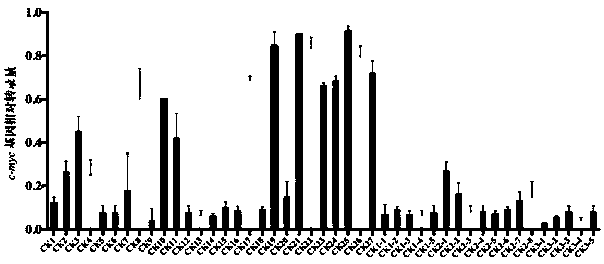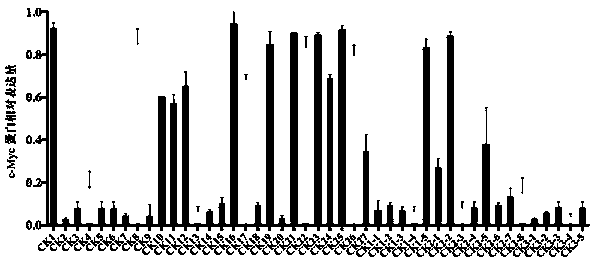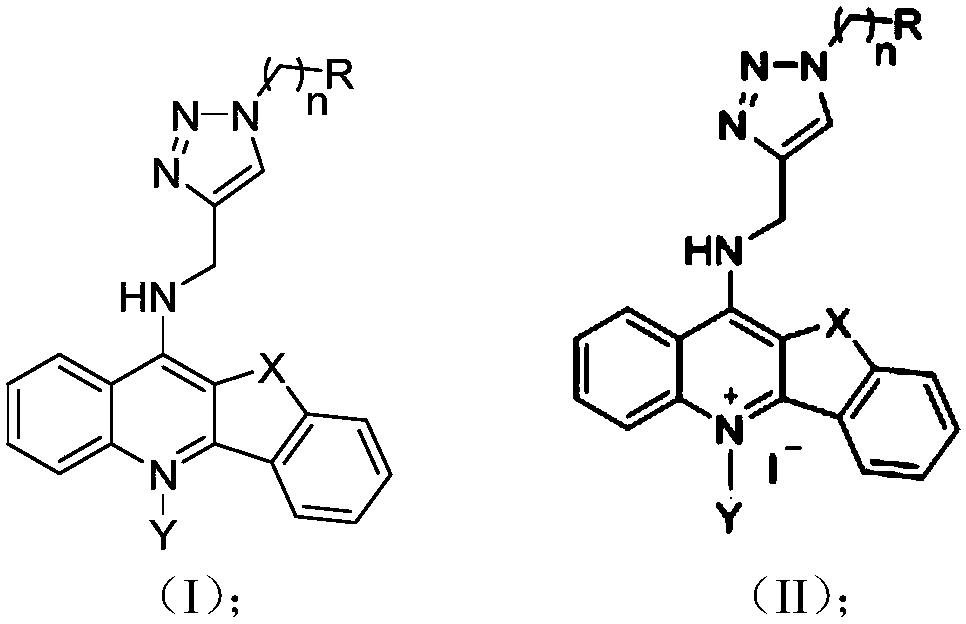A kind of quinoline derivatives and its preparation method and application in the preparation of antitumor drugs
A derivative and quinoline technology, applied in the field of medicinal chemistry, can solve the problems of limited resources, the need to improve the selection ability, and the limitation of anti-cancer applications, and achieve the effect of strong interaction
- Summary
- Abstract
- Description
- Claims
- Application Information
AI Technical Summary
Problems solved by technology
Method used
Image
Examples
Embodiment 1
[0054] Embodiment 1: the synthesis of compound S4
[0055] Dissolve 0.1mol of phenoxyacetic acid in 150mL of chloroform, add 17.5mL of thionyl chloride to reflux at 60°C for 3 hours, then remove the solvent by rotary evaporation under reduced pressure to obtain a brown liquid, then add acetonitrile as a solvent and mix with 0.1mol of anthranilic acid Formic acid undergoes condensation reaction to obtain S1. Then preheat PPA to 130°C and add S1 for ring closure reaction to obtain S2. Compound S3 was obtained by reacting S2 with thionyl chloride at 80°C under the catalysis of DMF. Then, 2.2 g of p-toluenesulfonic acid monohydrate was heated to 120° C. in a pressure-resistant tube, and then 5 mmol of S3 was added, stirred for 10 minutes, and cooled to room temperature. Add 10 mmol propargylamine, and react at 120° C. for 6 hours. Cool after the reaction is complete, dissolve the solid with 30mL chloroform:methanol=2:1, adjust the pH to 12 with 1N NaOH solution, extract twice wi...
Embodiment 2
[0058] Embodiment 2: the synthesis of compound CK1
[0059] Take compound S4 (0.25g, 1mmol) and place it in a 50mL single-necked bottle, add 10mL of tetrahydrofuran, add 2mL of pre-prepared solution containing (25mg, 0.1mmol) copper sulfate pentahydrate, 2mL of the existing solution containing (50mg, 0.2 mmol) of sodium ascorbate solution, and finally add 1.2 equivalents of: N,N-dimethyl-2-azidoethylamine. The reaction was stirred at 35°C and monitored by TLC. After the reaction was completed, the solvent was spin-dried and purified by column chromatography to obtain light yellow solid CK1 (mobile phase: dichloromethane:methanol=200-50:1; ammonia water 0.5%).
[0060] Yield 88%. m.p.121.5-122.6°C; 1 H NMR (400MHz, CDCl 3 )δ8.41(d, J=7.7Hz,1H),8.18(dd,J=8.5,0.7Hz,1H),7.94(d,J=8.5Hz,1H),7.71(s,1H),7.66– 7.58(m,3H),7.43(ddd,J=15.3,7.1,1.2Hz,2H),5.94(s,1H),5.36(d,J=5.8Hz,2H),4.38(t,J=6.2Hz ,2H),2.69(t,J=6.2Hz,2H),2.19–2.14(s,6H). 13 C NMR (101MHz, CDCl 3 )δ158.1, 147.1, 14...
Embodiment 3
[0062] Embodiment 3: the synthesis of compound CK2
[0063] The method is the same as in Example 2, except that N,N-diethyl-2-azidoethylamine is used instead of N,N-dimethyl-2-azidoethylamine to obtain light yellow solid CK2.
[0064] Yield 83%. m.p.133.1-134.3°C; 1 H NMR (400MHz, CDCl 3 )δ8.39(d, J=6.9Hz, 1H), 8.19(d, J=8.4Hz, 1H), 7.93(d, J=8.5Hz, 1H), 7.63(dt, J=19.1, 7.5Hz, 4H), 7.45(t, J=7.3Hz, 2H), 5.81(s, 1H), 5.36(d, J=5.8Hz, 2H), 4.33(s, 2H), 2.78(s, 2H), 2.40( d,J=6.9Hz,4H),0.79(t,J=6.9Hz,6H). 13 C NMR (101MHz, CDCl 3 )δ 158.1, 146.9, 146.7, 145.3, 133.8, 133.7, 130.1, 129.4, 128.1, 124.1, 123.3, 123.2, 122.8, 122.2, 120.4, 118.1, 111.8, 52.7, 49.0, 47.1, 40.9H, 12 pPLC. .HRMS(ESI)m / z:calcd for C 24 h 26 N 6 O,[M+H] + ,415.2241found 415.2246.
[0065]
PUM
 Login to View More
Login to View More Abstract
Description
Claims
Application Information
 Login to View More
Login to View More - R&D
- Intellectual Property
- Life Sciences
- Materials
- Tech Scout
- Unparalleled Data Quality
- Higher Quality Content
- 60% Fewer Hallucinations
Browse by: Latest US Patents, China's latest patents, Technical Efficacy Thesaurus, Application Domain, Technology Topic, Popular Technical Reports.
© 2025 PatSnap. All rights reserved.Legal|Privacy policy|Modern Slavery Act Transparency Statement|Sitemap|About US| Contact US: help@patsnap.com



